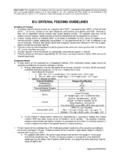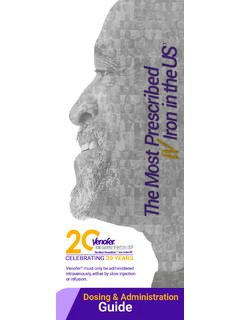Transcription of ESRD Conditions for Coverage (CfCs) Final Rule Rollout ...
1 ESRD Conditions for Coverage (CfCs) Final Rule Rollout Frequently Asked Questions (FAQs) 1. Q. When must the initial comprehensive assessment be completed on new patients? A. The initial assessment must be completed within the later of 30 calendar days or 13 outpatient hemodialysis sessions after the patient's first dialysis treatment. adequacy of the dialysis prescription must be assessed monthly for hemodialysis patients, and every 4 months for peritoneal dialysis patients. 2. Q. What are the requirements of the Quality Assurance and Process Improvement (QAPI) program? A. The new QAPI condition requires a dialysis facility to develop and implement a QAPI program of its own design that reflects the complexity of the facility's organization and services. The QAPI program requires facilities to achieve measurable improvements and reductions in medical errors by using appropriate indicators and performance measures.
2 The facility is required to continuously monitor its performance and take actions that result in performance improvements over time. 3. Q. When are facilities required to submit data electronically? A. Starting February 1, 2009, dialysis facilities will be required to submit data electronically to CMS s CROWNWeb system. 4. Q. Are the social worker and dietician required to complete their own initial social and nutritional assessments as in the past, or is it all part of the comprehensive assessment now? A. The ESRD Final Rule considers the social worker and dietitian part of the interdisciplinary team. Therefore, as we have stated in the preamble of the Final rule (73 FR 20395): The entire interdisciplinary team is responsible for ensuring that each patient is individually assessed and his or her needs identified, as required at We agree that in order to conduct a clinical assessment , the patient must have face-to-face contact with the other interdisciplinary team members.
3 We expect all professional members of the interdisciplinary team to complete the portions of the comprehensive patient assessment that are within their respective scopes of practice. It is not necessary for each professional team member to individually complete the entire comprehensive assessment and thereby duplicate efforts. Professional interdisciplinary team members might choose to conduct one-on-one interviews with patients to complete the assessments. The team may also opt to set up team meetings, which would include the patient, in order to collect the appropriate assessment information. We expect facilities to determine the best 8-28-2008 2way to manage this process, and create policies and procedures to accurately obtain patient assessment information. The assessment information is used to develop the patient s treatment plan and expectations for care, and thus it is critical for the members of the interdisciplinary team to participate.
4 5. Q. With respect to 42 CFR , it appears as if care plans will have to be updated monthly if and/or when lab values are out of the goal range, even on stable patients. Is this a correct interpretation of the rule? A. Lab values alone are not the only predictor of a change in a patient s status. We have set criteria for the unstable patient and have indicated in 42 CFR (d) (set out below) the parameters surrounding an unstable patient. We have also stated that the plan of care updates must occur when there is a change in the patient s status, moving them from stable to unstable, and back. (d) Standard: Patient reassessment. In accordance with the standards specified in paragraphs (a)(1) through (a)(13) of this section, a comprehensive reassessment of each patient and a revision of the plan of care must be conducted (1) At least annually for stable patients; and (2) At least monthly for unstable patients including, but not limited to, patients with the following: (i) Extended or frequent hospitalizations; (ii) Marked deterioration in health status; (iii) Significant change in psychosocial needs; or (iv) Concurrent poor nutritional status, unmanaged anemia, and inadequate dialysis.
5 In addition, we will allow a 15-day time period for the facility to implement any patient plan of care revision due to completion of a monthly assessment (done for unstable patients) or an annual assessment (completed for stable patients) (42 CFR (b)(2)). 6. Q. Can the comprehensive re- assessment be a review of the initial assessment with changes made when appropriate, or does it need to be the entire initial assessment done again? A. As CMS indicates in the preamble of the ESRD Final Rule at 73 FR 20399, the comprehensive reassessment process is part of a cycle. Accurate and timely patient information obtained through a patient assessment must be reflected in the plan of care. As the assessment changes, the plan of care must be revised accordingly. Once the patient is determined to be unstable, a monthly reassessment is necessary to update the plan of care appropriately.
6 A patient is unstable if he or she has had extended or frequent hospitalizations, or a marked deterioration in health status, or a significant change in psychosocial needs. In addition, a patient is unstable when he or she is determined by the interdisciplinary team to have poor nutritional status, unmanaged anemia, and inadequate dialysis concurrently. Unstable patients must be reassessed in accordance with 42 CFR (d), which specifies use of the assessment criteria at 42 CFR (a)(1) through (a)(13). While a comprehensive reassessment for patients classified as unstable is required, it is possible that patient status may not change in all parts of the assessment . Patient status, whether changed or unchanged, should be clearly reflected in the new assessment . In addition, the entire team is responsible for reassessing the patient.
7 8-28-2008 3 7. Q. Under Subpart D, condition (personnel qualifications), standard d (social worker), will there be any exceptions or grandfathering for social workers who do not have their specialization in "clinical practice"? A. The requirement for social workers to have a MSW from a school of social work accredited by the Council on Social Work Education with a specialization in clinical practice means that the social worker has to be skilled in assessing for psychosocial influences and their interrelatedness in predicting treatment outcomes, and must be able to design interventions with the patient, the family, the medical team, and community systems at large to maximize the effectiveness of ESRD treatment. This training received by MSWs enables them to perform these complex professional tasks and ensure effective outcomes that have a direct relationship to morbidity and mortality.
8 (See 73 FR 20423 and (d)(2)) CMS will be releasing surveyor interpretive guidance closer to the effective date of the ESRD Final Rule (10/14/08) which will further address this issue. 8. Q. Our hemodialysis unit receives many new patients who are admitted for short-term rehabilitation. The turnover in our clinic is unusually high. We have allowed our social workers to wait for the 30-day transient period to end before doing a comprehensive assessment and plan of care. Will CMS continue to allow this practice when the new Conditions for Coverage go into effect? A. CMS recognizes that dialysis facilities may experience difficulties in conducting assessments on patients who face a wealth of challenges, including frequent hospitalizations; however, these difficulties should not outweigh the need to complete a comprehensive initial assessment within a reasonable period.
9 If a patient has received dialysis for a 1-month period, or 13 hemodialysis treatments, that in-center patient has likely been physically present in the facility for at least 40 hours. Therefore, we believe that by allowing facilities 30 days or 13 hemodialysis treatments to complete the assessment (whichever is longer) we are providing a reasonable timeframe for every member of the interdisciplinary team to assess the patient before developing the treatment plan. 9. Q. Do renal technicians that do no nursing, medical, or patient care still have to be certified as patient care technicians? A. If a technician were not providing any patient care, he or she would not need to be certified as a patient care technician (PCT). If they do provide any patient care, then they must be certified as PCTs, pursuant to (e).
10 Please note that if these technicians perform monitoring and testing of the water treatment system, they must complete a training program approved by the facility s governing body and the medical director as specified at 42 CFR (f). 10. Q. Our attending physician and medical director fulfill both roles for 90% of our patients. How can we meet the requirement of having "both" physicians sign the discharge order? 8-28-2008 4A. The physician would sign the discharge order in both places on the order form. In this instance, the dialysis facility must have a policy and procedure denoting the roles and responsibilities of the physician, both as the attending physician and medical director. 11. Q. Can a physician extender be used in place of monthly physician visits or do patients have to be seen by a physician at least once a month?











